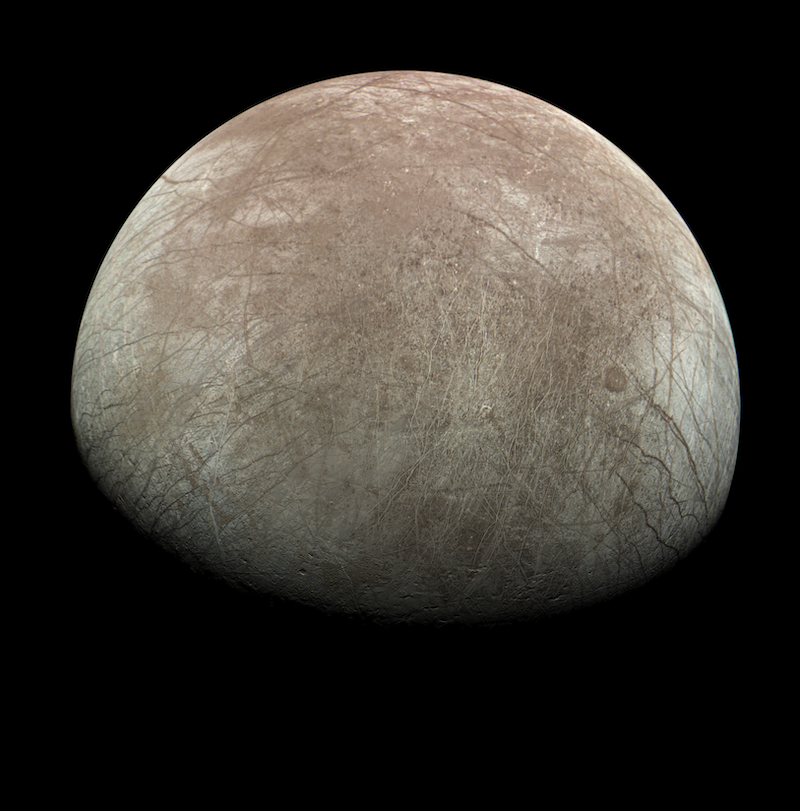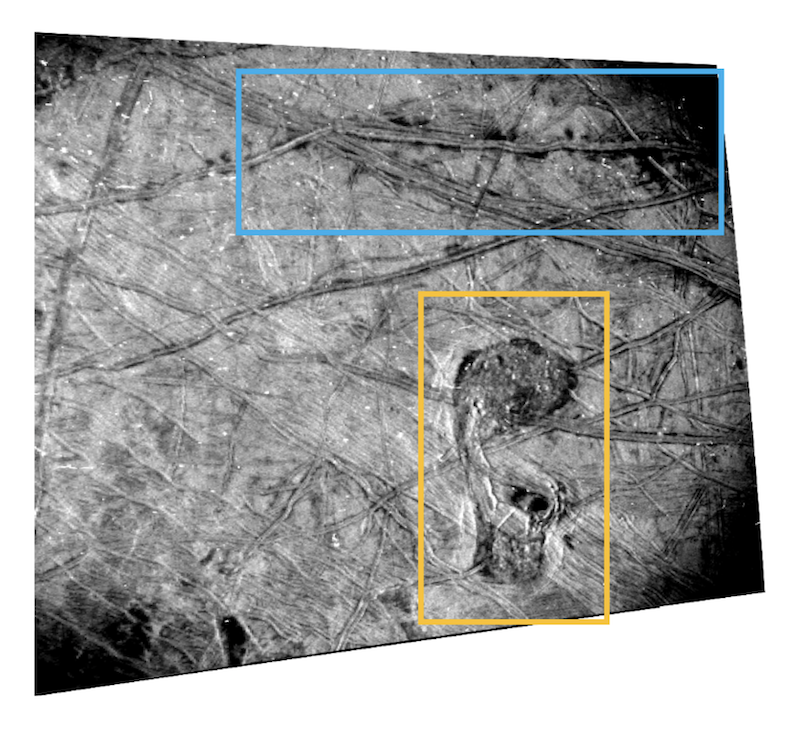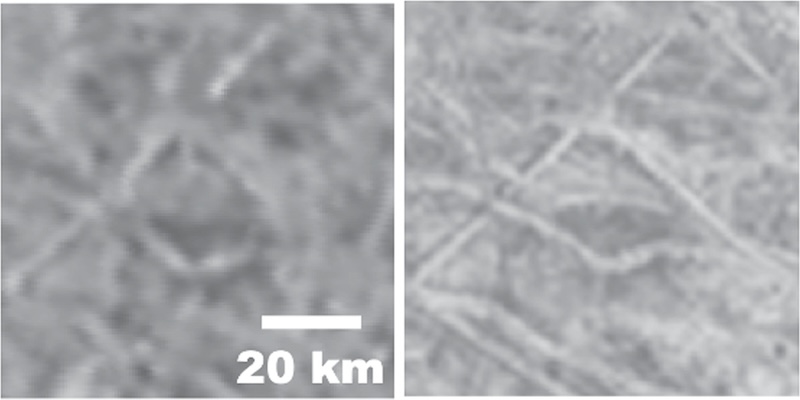- NASA’s Juno mission has provided images and new details about Jupiter’s ocean moon Europa.
- The findings suggest the moon’s ice shell floats on top of the ocean and can move around in a process called true polar wander.
- The images also reveal more evidence for previous water vapor plumes that left cryovolcanic deposits on Europa’s surface and places where watery brines may have trickled up to the surface.
Space fans are eagerly awaiting the upcoming Europa Clipper mission, which will provide our closest look yet at Europa, Jupiter’s intriguing ocean moon. It’ll launch this coming fall. In the meantime, scientists have been analyzing some new high-definition images from the Juno spacecraft, which has been orbiting Jupiter since 2016. NASA said on May 15, 2024, that Juno didn’t detect any active plumes of liquid on Europa, like those we see on Saturn’s moon Enceladus. But the newly-released images do support the hypothesis that Europa’s crust is free-floating on an ocean below. And they show signs of deposits from ice volcanoes (cryovolcanoes) on the surface from possible earlier water vapor plumes. Plus there’s a “disappearing crater” and an unusual “platypus”-shaped feature.
Juno obtained these images on September 29, 2022. They’re the closest ones yet of Europa. The peer-reviewed results are presented in two new papers, one in The Planetary Science Journal (March 21, 2024) and the other in JGR Planets (December 22, 2023).
The JunoCam instrument took four of the images and the Stellar Reference Unit (SRU) obtained one image. Juno came within 220 miles (355 kilometers) of the moon’s frozen, icy surface.
Free-floating ice shell

One big finding is that the images support the theory that Europa has experienced true polar wander. The theory states that Europa’s ice crust is free-floating on top of the ocean below. That means the ice shell can move. The images showed irregularly distributed steep-walled depressions 12 to 31 miles (20 to 50 kilometers) wide. The depressions resemble large ovoid pits previously that scientists have seen in imagery from other locations on Europa.
Candy Hansen is the lead author of the first paper, at the Planetary Science Institute in Tucson, Arizona. She said:
True polar wander occurs if Europa’s icy shell is decoupled from its rocky interior, resulting in high stress levels on the shell, which lead to predictable fracture patterns. This is the first time that these fracture patterns have been mapped in the southern hemisphere, suggesting that true polar wander’s effect on Europa’s surface geology is more extensive than previously identified.
Disappearing crater
Gwern crater was thought to be one of the few craters visible on Europa’s surface, about 13 miles (21 km) across. But the new Juno images revealed it to be an illusion. As Hansen explained:
Crater Gwern is no more. What was once thought to be a 13-mile-wide impact crater – one of Europa’s few documented impact craters – Gwern was revealed in JunoCam data to be a set of intersecting ridges that created an oval shadow.
As a result, the number of known craters larger than one km on Europa is now 40 instead of 41.

The Platypus
One of the intriguing features seen in the images is nicknamed the Platypus, given its shape. It’s 23 miles (37 km) wide by 42 miles (68 km) long and geologically younger than the surrounding terrain. It is an area of chaos terrain, featuring hummocks, ridges, and dark reddish-brown material inside it. The “torso” and “bill” are connected by a “neck” that is fractured. There are also many ice blocks ranging from 0.6 to 4.3 miles (1 to 7 km) wide.
The researchers said that this may be an area where briny water from below has reached the surface. The paper stated:
Although its topographic context is not well understood due to the absence of stereo for this region, our morphological findings from shape-from-shading and visual interpretation are consistent with multiple predictions made by the melt lens model for chaos formation. That model predicts the presence of subsurface liquid, and ongoing formation activity in features where surface ice subsides and ice blocks float below the surrounding terrain.
Plume deposits in images of Europa?
Scientists have previously seen hints of water vapor plumes on Europa, similar to those on Saturn’s moon Enceladus. They seem to be smaller and less frequent, however. Another feature in the Juno images supports the plume hypothesis. It is a set of double ridges flanked by dark stains, about 31 miles (50 km) north of the Platypus. It is an ideal target for NASA’s upcoming Europa Clipper mission and the ESA’s Jupiter Icy Moons (Juice) mission. Heidi Becker, lead co-investigator for the SRU at NASA’s Jet Propulsion Laboratory in Southern California, said:
The SRU’s image is a high-quality baseline for specific places NASA’s Europa Clipper mission and ESA’s (European Space Agency’s) Juice mission can target to search for signs of change and brine.
Juno did not detect any signs of current plume activity during its observations. That doesn’t mean there aren’t any eruptions happening at all though, as the paper noted:
However, an eruption would have to occur at just the right longitude (limb or terminator) and just the right time when Juno flew by, so the probability of a detection was never very high

Europa Clipper and Juice
Europa Clipper, as the name implies, will focus on Europa, making numerous close flybys of the moon. It will reveal more details about both Europa’s surface and subsurface ocean. It will launch later this year and arrive in 2030.
ESA’s Jupiter Icy Moons Explorer (Juice) is already on its way to Jupiter, launched on April 14, 2023. It will reach Jupiter in July 2031. Unlike Europa Clipper, it will study Jupiter, its rings and numerous moons, with a focus on the largest moon, Ganymede.
Juno has already conducted 61 close flybys of Jupiter itself, the latest being on May 12, 2024. The next one will be on June 13, where the spacecraft will also come to within 18,200 miles (29,300 km) of the volcanic moon Io. Launched on August 5, 2011, Juno has been exploring Jupiter and its moons since 2016. Its primary mission is to study the giant planet’s atmosphere and interior, but it does sometimes conduct flybys of some the larger moons as well.
Bottom line: NASA has released some images of Europa, the ocean moon of Jupiter. They provide new clues about the moon’s ice shell and other intriguing surface features.
Source: Juno’s JunoCam Images of Europa
Read more: Europa has enough oxygen to support a million people











